#kambara taraina
Text



Isn't etymology fun? Look at all the fun we're having.
This isn't even the only croc who's name translates to "Crocodile Crocodile"
236 notes
·
View notes
Text
Kambara
Here I go again with croc stuff. Back to dealing with stuff thats longer established, let me tell you about Kambara, the oldest named mekosuchine and a genus that surprised me with the bulk of information behind it.
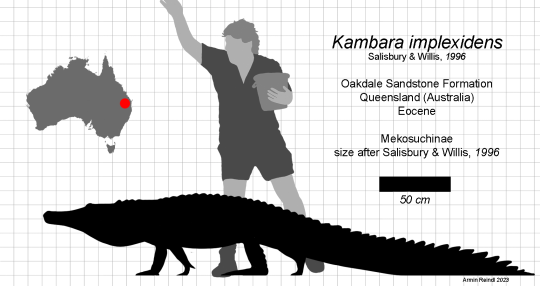
Kambara (which simply translates to "crocodile") is a genus of early mekosuchine that as of July 2023 contains four species, all from the Eocene of Queensland.
The first of these are Kambara murgonensis (Crocodile from Murgon) and Kambara implexidens (Interlocking Teeth Crocodile), both of which found at the same locality in Murgon, Queensland. The bones of both were in fact so intermingled that it was initially assumed that they represented a single species with highly variable anatomy, before the second species was recognized 3 years later.
There are a couple of differences between, but two are easiest to point out. For one, although being in the same size range (3-3.5 meters as adults), Kambara implexidens was a little more gracile. Furthermore, and the defining difference between them, K. implexidens (left) had interlocking teeth like a crocodile (bottom left), but K. murgonensis (right) had an overbite like an alligator (bottom right).

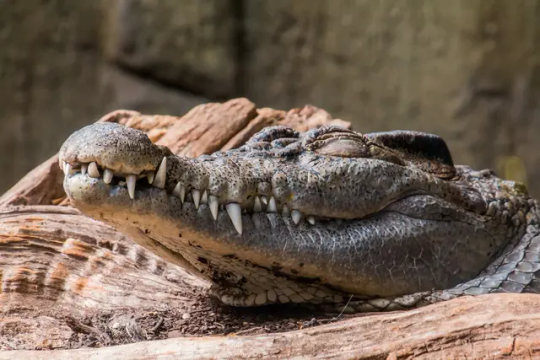

The next species named after these two was Kambara molnari (Molnar's Crocodile), but it's only known from much more limited material, the holotype being a lower jaw. Still some interesting information from this can be gathered. Which is that K. molnari seemingly represents an intermediate between interlocking dentition and an overbite. K. molnari wasn't found near Murgon, but in a different basin in Queensland, in the lower layers of the Rundle Formation.
Also from the Rundle Formation we have the most recently named and geologically youngest species, Kambara taraina (Crocodile Crocodile). Yeah the name is a bit redundant, but the logic of basing the species name on the Darumbal dialect as a proxy for language of the Bailai People is a nice one. Anyhow, K. taraina is a return to form as it is also known from good material like the first two, stemming from yet another large fossil bed possibly representing a mass death site. It had interlocking dentition like K. implexidens, BUT, unlike the oldest two species it did not coexist with the other Rundle Kambara. Instead, K. taraina came after K. molnari had presumably gone extinct.
Shown below the paratype of K. taraina, the holotype of K. implexidens and the holotype of K. molnari.

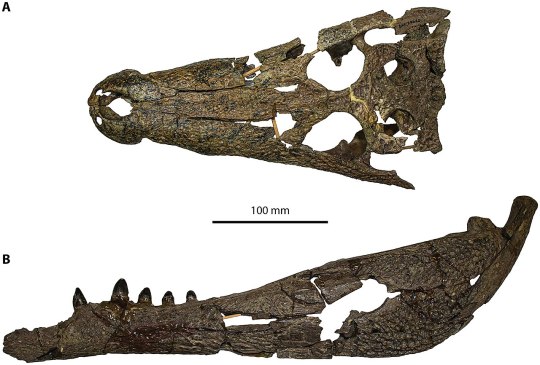
I won't get into phylogeny too much other than that its usually thought off as one of the earliest branching mekosuchines, but details vary. Lee and Yates found that Australosuchus may be more basal, while Ristevski et al. recover Kalthifrons as the earliest branch, in both cases Kambara is only the second branching.
There is one slightly odd alternative. Rio and Mannion do find it as the oldest branching mekosuchine....but also regard neither Quinkana nor Australosuchus as members of the clade...and further seemingly find "Asiatosuchus" germanicus to nest within Kambara? And then there's 2 out of the 8 trees by Ristevski, which show Kambara as a close relative to modern Crocodylids. But neither of those results match the current concensus and Rio and Mannion in general has a lot I disagree with.
Much more interesting is the postcrania and the implications for the lifestyle of Kambara. Now while we have a lot of bones from the rest of the body, given they were found in literal bonebeds, we don't know much about it. Crocodile fossils that aren't skulls are rarely described in detail. But there's still some information out there. Important here are Stein et al. 2012 and Buchanan's PhD thesis (which included the description of K. taraina, the one part that was formally published). Both looked at the postcrania and found that there are some differences to modern crocs. To keep things brief, while the anatomy is not nearly as derived as in a fully terrestrial croc, it does seem to suggest that Kambara would have had an easier time performing the crocodilian highwalk (shown below).
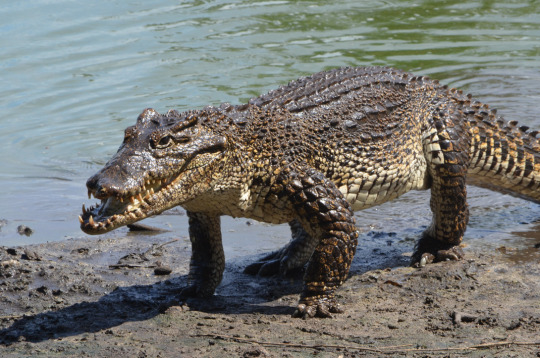
Again, this does not necessarily mean it lived on land, if anything the circumstances of the animals death seems to imply the opposite, but its still interesting. Buchanan suggests that this could have been used to walk through shallow water or bottom walking, and Stein et al. do point out that some adaptations of the limbs could also be advantages while swimming. The most important part to suggest that Kambara still lived in the water is the skull tho (well and it being found in freshwater habitats). The skull looks still remarkably like that of your generalist croc, somewhat flattened, nostrils on top, raised eyes, all that kind of stuff. So it presumably hunted like a modern croc and lived like a modern croc.
The exact lifestyle remains obscure tho. Again, generalist seems like the best supported hypothesis, but we don't know what kind of difference interlocking teeth and the overbite make. Theres some speculation of course. Mook for example proposed that an overbite functions like carnassial teeth in mammals, slicing and breaking, whereas interlocking dentition is better for gripping. While the difference in robustness between K. murgonensis and K. implexidens isn't that great, it could be suggested that the more robust species sliced and broke larger prey while the more gracile one dealt with slippery fish or struggling animals. Muscle attachments are also important, and those seem to show that the most recent species, Kambara taraina with interlocking teeth, had the greatest bite force and thus may have fed on larger prey than all its predecessors. But again, a lot of this requires further looking into.
We do have one singular piece of evidence for diet. The shell of a turtle from the Rundle Formation clearly bearing the tooth marks of Kambara. The bite marks show that the turtle was bitten multiple times, likely in an attempt to position it better in the mouth to bring it into position with the crushing back teeth or to swallow. Fun fact, this behavior is referred to as "juggling". But as you can see from the first figure, the Kambara in question was a bit cocky and picked a turtle way too large, eventually giving up. Sadly the turtle was very injured, and tho the wounds healed slightly, it eventually died from an infection.

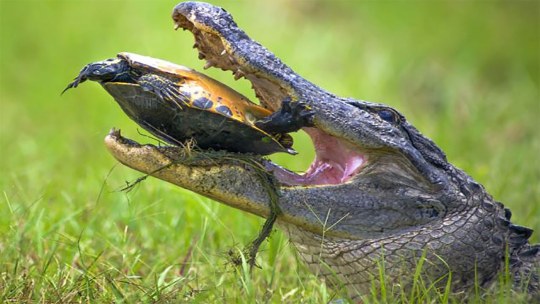
For the last section I briefly want to cover some last notes on Kambara murgonensis and Kambara implexidens, more specifically their coexistence. Now I covered the potential difference in hunting and prey preference already, but theres some other stuff to consider. For example, although found in the same locality, it is possible that this cohabitation was not the status quo. Given it is a mass death site at a locality that is known to have undergone wet and dry seasons, it is not unreasonable to assume that these animals died during a drought (another point against terrestrial life too, as they could have just left otherwise). Now even today crocs will gather in large groups in such situations, trying to make the most of dwindling water sources. This could mean that both species typically inhabited different biomes and only came together because they were forced to. The same might have also happend to Kambara taraina, causing increased aggression and explaining the many injured specimens found. Anyhow, it is also a possibility that they weren't divided by species, but by size, age and maturity. Buchanan points out that there are different habitat preferences between nesting females and juveniles, subadults and adult males in modern saltwater crocodiles. Big males prefer open water, nesting females areas with denser vegetation and subadults should avoid both as they threaten hatchlings and could be eaten by cannibalistic males. So that could also factor into the distribution of Kambara. And notably, it is pointed out that the Murgon site preserves both hachlings and egg shales, but seems to lack animals of intermediate size, which could suggest it was a nesting site.
Below a picture of an American Alligator and an American crocodile, simply because they remind me of Kambara and are an example of crocodilians that overlap in range, yet aren't super different like lets say Muggers and Gharials.
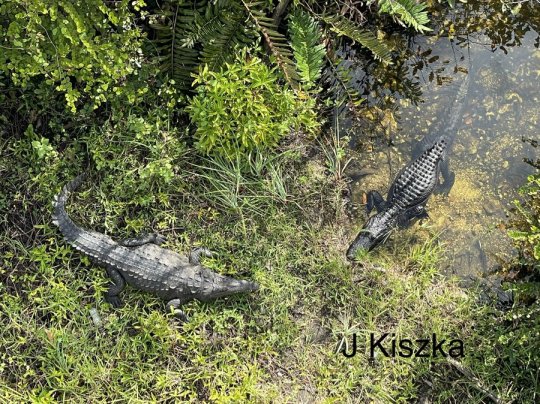
Alas Kambara suffers the mekosuchine curse, which is to say even with overwhelming material not much is actually published. Two bonebeds with all sorts of material, yet only 5 papers to its name, generally just accounting for the type description of each species + the humerus paper.
A lot of the info presented is actually from L.A. Buchanan's PhD thesis, which did include the description of Kambara taraina. However, since the completion of the thesis in 2008, only the description of the species was actually published. Entire chapters dealing with pathologies, postcrania and potential ecological inferrence are all are only present through the thesis, which has thankfully been uploaded in 2017.
Nevertheless, its a fascinating animal and I hope I made some people curious.
Wikipedia page:
Kambara - Wikipedia
#croc#crocodile#mekosuchinae#crocodilia#eocene#palaeoblr#prehistory#paleontology#long post#australia#skeletal#pseudosuchia#kambara#kambara implexidens#kambara murgonensis#kambara molnari#kambara taraina
75 notes
·
View notes
Note
About Kambara.
While the implementation is sloppy, isn't it still good to have minority languages represented in academia? And isn't it not that unusual to have a repetitive binomial, like with Crocodilus suchus as you've shown or Gorilla gorilla and the like?
Sorry if I sound a bit standoffish. Usually, complaints about nomenclature containing indigenous or other minority languages ping my suss radar, and I don't want folks to be encouraged to dismiss attempts at inclusion in science. Not that I think you were intending that, I mostly felt like as far as taxonomic names go, there can be far worse.
Rest assured that the post was meant to be somewhat tongue and cheek. I don't carry any ill will against Kambara taraina or the naming of it, rather I simply find it quite humerous that the authors went out of their way to make a redundant scientific name (which isn't as typical in fossil taxa as it is in modern ones), regardless of which language they chose to convey it in.
Kambara is definitely a great name and it goes along nicely with several other Australian crocodilians having been given names derived from indiginous languages.
Mekosuchus for example derives from Mek, the Drehu name of Grande Terre
Gunggamarandu combines Barunggam and Wakka Wakka words to mean "river boss" (which funnily enough is kind of just an alteration of Paludirex's name meaning swamp king)
Baru and Quinkana, two other iconic names imo, both derive their meaning from Dreamtime stories.
It's definitely a trend I hope to see continued, perhaps even with "Baru" huberi which is most likely in need of a distinct genus name anyways.
Outside of Australasia you also have stuff like Tsoabichi (from Shoshoni for monster), Voay (another instance of just crocodile but this time in Malagasy), Gnatusuchus (latinized Quechua for nose) and Kuttanacaiman (again from Quechua for cutting/grinding machine) to name a few.
4 notes
·
View notes